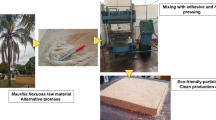Abstract
The fire-retardant performance of wood particleboards treated with three percentages (8, 12, and 16%) of boric acid was determined. Particles were treated during wood particles blending with adhesive. Fire-retardant properties were measured according to ASTM D3806 Standard Test Method of Small-Scale Evaluation of Fire-Retardant Paints, (2-Foot Tunnel Method). Particleboards treated with 16% boric acid showed the best fire-retardant properties, particularly in terms of weight loss, flame spread speed and afterflame time. The use of white birch inner bark particles as dispersant also lowered particleboard weight loss during fire testing. The use of boric acid not only decreased the flame spread speed but also greatly improved the internal bond and thickness swelling of manufactured particleboards over controls.
Zusammenfassung
Untersucht wurde das feuerhemmende Verhalten von Spanplatten, die mit 8, 12 und 16 % Borsäure imprägniert wurden. Die Imprägnierung der Späne erfolgte im Rahmen der Klebstoffzugabe. Die feuerhemmenden Eigenschaften wurden gemäß ASTM D3806 im Kleinprüfstand bestimmt (2-Fuß-Tunnelmethode zur Prüfung feuerhemmender Anstriche). Die mit 16 % Borsäure behandelten Spanplatten zeigten die besten feuerhemmenden Eigenschaften, insbesondere hinsichtlich Masseverlust, Flammenausbreitungsgeschwindigkeit und Nachbrennzeit. Die Verwendung von Bastpartikeln der Papierbirke als Dispersionsmittel führte ebenfalls zu einer Reduzierung des Masseverlustes der Spanplatten beim Brandversuch. Die Verwendung von Borsäure hatte nicht nur einen Rückgang der Flammenausbreitungsgeschwindigkeit zur Folge, sondern führte auch zu einer Verbesserung der Querzugfestigkeit und der Dickenquellung der hergestellten Spanplatten im Vergleich zu den Kontrollplatten.








Similar content being viewed by others
References
ASTM D 1037-99 (2005) Standard test methods for evaluating properties of wood-based fiber and particle panel materials. In: ASTM annual book of standards, vol 04.10. West Conshohocken, PA, pp 140–170
ASTM D 3806-98 (2001) Standard test method of small-scale evaluation of fire-retardant paints (2-foot tunnel method). In: ASTM annual book of standards, vol 06.01. West Conshohocken, PA, pp 420–424
Ayrilmis N, Candan Z, White R (2007) Physical mechanical and fire properties of oriented strandboard with fire retardant treated veneers. Holz Roh- Werkst 65:449–458
Basson GR, Conradie WE (2001) Preservative and fire-retardant composition and combination and process. United States Patent # 6319431
Hshieh FY, Beeson HD (1997) Flammability testing of flame-retarded epoxy composites and phenolic composites. Fire Mater 21:41–49
Hume J (1992) Assessing the fire performance characteristics of GRP composites. In: International conference on materials and design against fire, London, pp 11–15
Luneva NK, Petrovskaya LI (2008) Performance of intumescent fire retardant for wood. Russ J Appl Chem 81(4):704–707. ISSN 1070-4272
Montgomery DC (1997) Design and analysis of experiments, 4th edn. Arizona State University
Mouritz AP, Gibson AG (2006) Fire properties of polymer composite material. Springer, Berlin, pp 59–101, Chap 3
Pereyra AM, Giudice CA (2009) Flame-retardant impregnants for woods based on alkaline silicates. Fire Saf J 44:497–503
Plotnikova GV, Egorov AN, Khaliullin AK (2003) Flame retardants for wood, based on urea-formaldehyde resin with mineral filler. Russ J Appl Chem 76(2):310–313
Rowell RM, LeVan-Green SL (2005) Thermal properties. In: Rowell RM (ed) Handbook of wood chemistry and wood composites, Boca Raton, London, New York, Washington, DC, pp 121–138, Chap 6
Saka S, Sasaki M, Tanahashi M (1992) Wood-inorganic composites prepared by sol-gel processing. I. Wood-inorganic with porous structure. Mokuzai Gakkaishi 38(11):1043–1049
Tang Y, Wang DY, Jing XK, Ge XG, Yang B, Wang YZ (2008) A formaldehyde-free flame retardant wood particleboard system based on two-component polyurethane adhesive. J Appl Polym Sci 108:1216–1222
Terzi E, Kartal SN, White RN, Shinoda K, Imamura Y (2009) Fire performance and decay resistance of solid wood and plywood treated with quaternary ammonia compounds and common fire retardants. Eur J Wood Prod
Yunchu H, Peijang Z, Songheng Q (2000) TG-DTA studies on wood treated with flame-retardants. Holz Roh- Werkst 58:35–38
Acknowledgements
Thanks to the Fonds québécois de la recherche sur la nature et les technologies (FQRNT), chaires de recherche du Canada, FPInnovation-Forintek division, and Université Laval for providing financial support for this research.
Author information
Authors and Affiliations
Corresponding author
Rights and permissions
About this article
Cite this article
Pedieu, R., Koubaa, A., Riedl, B. et al. Fire-retardant properties of wood particleboards treated with boric acid. Eur. J. Wood Prod. 70, 191–197 (2012). https://doi.org/10.1007/s00107-011-0538-y
Received:
Published:
Issue Date:
DOI: https://doi.org/10.1007/s00107-011-0538-y




